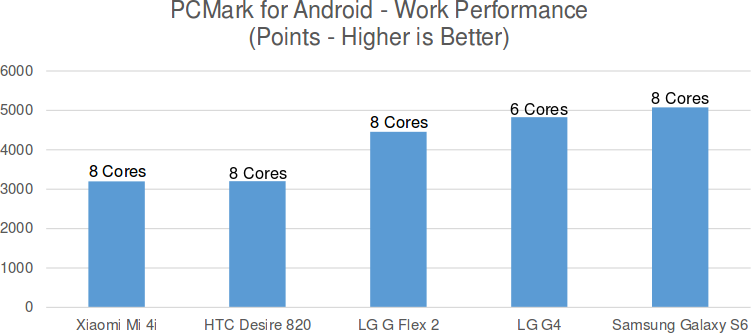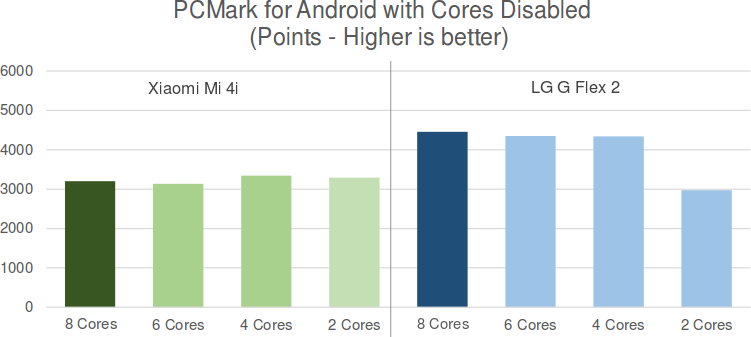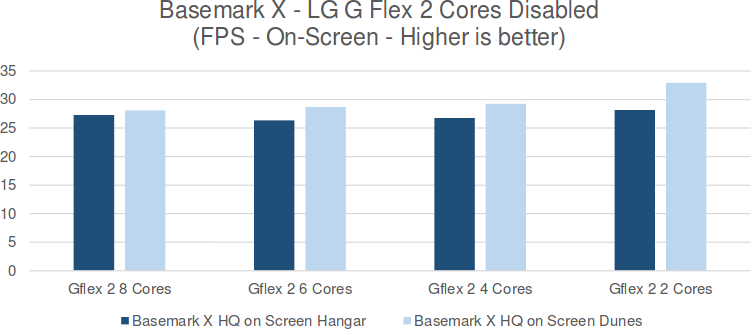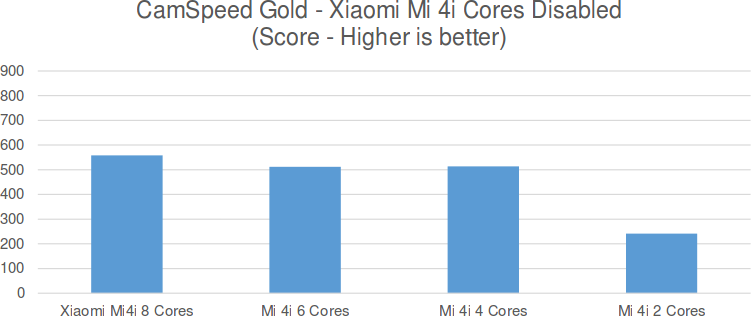Silicon vendor are now launching 8-core and even 12-core processors for mobile devices, and I can see some advantages in terms of power consumption in processors leveraging big.LITTLE processing with low power ‘LITTLE’ cores running light tasks such as audio or video playback, while performance ‘big’ cores running much demanding tasks. However, some processors, such as RK3368, feature the same eight cores, and in real-use don’t bring that extra bit of performance or lower power consumption, except in very specific cases. So the only “advantage” of this type of processor is a marketing one, with keyword like “Octa-core”, “64-bit”, etc… Last year, I found out, that more powerful cores may be more important than many cores, when I tested Allwinner A80 processor with PVRMonitor to check CPU usage per core in real-time, and in Antutu, while Browsing the web or playing games, only a few cores were used most of the time, and rarely all eight cores were needed.

Moor Insight and Strategy, a high-tech analyst firm, benchmarked five smartphones in order to find out whether the number of cores mattered, and when possible disabled a few cores during testing to get an idea of the performance difference between 2-, 4- and 8- core performance.
The five smartphones under test were:
- LG G4 with a Qualcomm Snapdragon 808 2x Cortex-A57 + 4x Cortex-A53 processor (6 cores) – Android Lollipop
- Samsung Galaxy S6 with Samsung Exynos 7420 4x Cortex-A57 + 4x Cortex-A53 processor (8 cores) – Android Lollipop
- Xiaomi Mi 4i with Qualcomm Snapdragon 615 8x Cortex-A53 processor (8 cores) – Android Lollipop
- HTC Desire 820S with MediaTek MT6752 8x Cortex-A53 processor (8 cores) – Android Kitkat
- LG G Flex 2 with Qualcomm Snapdragon 810 4x Cortex-A57 + 4x Cortex-A53 processor (8 cores) – Android Lollipop
The three benchmarks:
- Futuremark PCMark for Android Work Performance v1.1 for Web browsing, video, writing, and photo editing
- Basemark X for Android v1.1 for 3D gaming
- Sofica CamSpeed for Android v2.31 to evaluate the phone camera performance
They also ran YouTube v10.24.57 and WeChat v6.2 apps, as well as Qualcomm Trepn Profiler to measure clock speed and load, and 3D CPU manager to disable cores on devices that supported (rooted + hotplug support) it, which sadly, meant only LG G Flex 2 and Xiaomi Mi 4i.

One of their first remark was to notice that LG G4 with its 6-core processor outperformed almost all smartphones based on 8-core processors. This should have been expected since two of the eight cores smartphone are only running low power (and performance) Cortex A53 cores while LG G4’s Snapdragon processor comes with both A57 and A57 cores, but I guess it still shows to consumers that an 8-core is not necessarily faster than 6-core smartphone.
The more interesting part of the study is when they disable cores with on the same device with 3D CPU Manager.
 The chart above shows that PCMark results are the same with 2, 4, 6 or 8 on Xiaomi Mi 4i, and results only drop on LG G Flex when switching from 4 to 2 cores, and the only reason is that only two Cortex A53 cores were active, while at lest two Cortex A57 cores were active when 4 to 8 cores were enabled.
The chart above shows that PCMark results are the same with 2, 4, 6 or 8 on Xiaomi Mi 4i, and results only drop on LG G Flex when switching from 4 to 2 cores, and the only reason is that only two Cortex A53 cores were active, while at lest two Cortex A57 cores were active when 4 to 8 cores were enabled.
 In 3D graphics tests with Basemark X, there was little differences between 2, 4, 6 or 8 cores activated, and amazingly they even noticed a slightly better performance with 2 cores compared to 8 cores. They repeated the tests several times with the same, and assumed it might be due to thermal throttling as the processor would heat more with 8 cores…
In 3D graphics tests with Basemark X, there was little differences between 2, 4, 6 or 8 cores activated, and amazingly they even noticed a slightly better performance with 2 cores compared to 8 cores. They repeated the tests several times with the same, and assumed it might be due to thermal throttling as the processor would heat more with 8 cores…
 The camera benchmark however showed a clear improvement with 4 cores over 2 cores (the same Cortex A53 cores), but very little improvement when 6 or 8 core were enabled.
The camera benchmark however showed a clear improvement with 4 cores over 2 cores (the same Cortex A53 cores), but very little improvement when 6 or 8 core were enabled.
Finally, while testing apps they found out that YouTube would play 1080p video in Xiaomi Mi 4i with 2 cores enabled, except when UI calls may cause a slowdown, which disappeared with 4 cores or higher. Unsurprisingly, WeChat ran perfectly fine on two cores…
Their conclusion was that CPU core count was not an accurate measurement of performance or performance, and that more CPU cores is not always better. They called on phone manufacturers and carriers to stop promoting the number of cores as a selling point, and instead improve benchmark practices and education.
If you feel like it, you can also watch the 49-minute benchmark session.
The white paper can be downloaded here.
Via ExtremeTech and thanks to Milkboy for the tip!

Jean-Luc started CNX Software in 2010 as a part-time endeavor, before quitting his job as a software engineering manager, and starting to write daily news, and reviews full time later in 2011.
Support CNX Software! Donate via cryptocurrencies, become a Patron on Patreon, or purchase goods on Amazon or Aliexpress





http://www.anandtech.com/show/9518/the-mobile-cpu-corecount-debate
@renw0rp
Very interesting, and just posted today.
So Anandtech results are that browser like Chrome, and the camera app do use all 8 cores for short period of times, but the two games they tested did not.
Well of course 8 core are mostly a marketing gimmick but if 4 are low power ones and 4 are high power ones then it does make sense as this cand save power. Even if not all 8 core are being used at the same time having all 8 makes sense in this case. Also since the hardware is there and in some many phones, even cheaper ones we might get more software capable of using 8 cores. There’s a problem though, most 8 core SOCs are probably not comfortable having all 8 cores and the GPU running at close… Read more »
“Call to action”? For marketers? What on earth for? Single numbers will forever be used for marketing – it’s an easy to assert and digest, and (legally) correct value, even if it doesn’t mean anything of itself (marketing in a nutshell?). Number of cores or Mhz or “IPC” or ‘burst frequency’, etc. After 8 the number of cores will probably lose it’s marketing lustre anyway (we’ll run out of fingers) and they’ll be forced to find some other way to sell new kit. Transcending simple numbers into other forms of marketing doesn’t make it any more honest (‘intel inside’, ‘retina’,… Read more »
And another observation. This just looks like a bit of self-funded marketing by some financial analysts. They are just making it up as they go along and all it really demonstrates is that they can use a word processor – and not particularly well either. Maybe it was just a job given to the work-experience kid as neither the composition, layout, or graphics are particularly noteworthy. Anandtech and their ilk are likewise just laymen who are mostly just reformatting press releases or tallying software-generated reports and then creating readable but otherwise naive and technobabble-heavy conclusions out of thin air. TBH… Read more »